The Long Game
Greg Martin
Liberty Wildlife Contributor
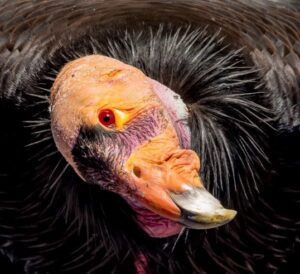
California Condors are dying today from a pesticide banned by the Environmental Protection Agency in 1972.
Think about that.
DDT, first deployed during World War II to shield G.I.s from disease-carrying hostile insects, is still  causing unintended destruction nearly 50 years after scientists correctly identified its devasting collateral effect on exposed environments.[1]DDT has long been one of the poster cases for detrimental environmental toxins; its prohibition and the subsequent recovery of impacted species, most famously the Peregrine Falcon, stand out amidst the great conservation success stories of the twentieth century.
causing unintended destruction nearly 50 years after scientists correctly identified its devasting collateral effect on exposed environments.[1]DDT has long been one of the poster cases for detrimental environmental toxins; its prohibition and the subsequent recovery of impacted species, most famously the Peregrine Falcon, stand out amidst the great conservation success stories of the twentieth century.
So why is it reemerging as an issue in 2019?
DDT travels through the veins of the local food web from the bottom up, eventually impacting the entire ecosystem like one composite body. The pesticide affects insects; other animals eat the insects; even larger animals eat those animals, and so forth: before long, every creature along the path consumes it, with the damage it causes varying based on size and species. In large birds, DDT is an indirect killer; rather than proving fatal in and of itself, high enough levels accumulated within females cause defects in the egg laying process, leading to thin shells that too often collapse under the weight of their own mother’s warmth. Broken eggs mean no new young, which can quickly lead to extinction. This nearly happened to both the Peregrine Falcon and the Bald Eagle. But that was a long time ago, and the lesson was very well learned.

The problem for the California Condors who live in coastal regions of their namesake state is that Mother Nature often plays the long game. DDT was prohibited as a pesticide in 1972, but a great deal of it found its way into the Pacific Ocean before its true dangers were known.[2] DDT became entrenched throughout all levels of the local underwater world as small animals devoured bigger ones. And since the very biggest (think sea lions and whales) enjoy substantial lifespans, there was ample opportunity for toxin levels in individuals to build up higher and higher.
Condors, being the titanic scavengers they are, quite naturally flock to carrion wherever it presents itself. And a beached whale is an epic feast for a score of winged leviathans living nearby. While performing their natural role of cleansing beaches of their dead, they inadvertently consume flesh saturated with DDT; little by little, it builds up in them as well, and before long, the effects make themselves known.[3]Thin shells. Broken eggs. Lost opportunities to breed. And such opportunities are both rare and crucial for a critically endangered species that only reaches breeding maturity between six and eight years old, and only produces a single offspring per year, if that.[4]Condors already face the threat of poison through their accidental consumption of lead bullet fragments discarded in the remains of hunters’ kills. The ghost of an 80-year-old horror is one problem too many for a majestic animal already fighting for its very life.
While efforts to save the condor from lead poisoning through copper bullet programs and other outreach initiatives remain ongoing, not much can be done about poisons released 50 years ago or more. As DDT was long ago recognized as a threat, all that remains is to confront its aftershocks; beaches can be diligently monitored for dead sea life, then cleaned before the birds arrive to do their job as nature intended. As only a certain segment of the remaining condor population dwells in coastal regions, DDT is not the species killer it once was, although fractured eggs weigh heavily on a species where every new member is crucial.
If there is a danger in DDT’s modern reemergence, there remains also a lesson: every action, big and small, that each of us takes on this planet Earth has consequences, and it is worth considering them in full. No one can plan for every eventuality – and certainly, even the most well thought out actions can have consequences later in life – but that only means that vigilance is key to combatting unforeseen developments as they occur.
After all, it can take a long time for the next domino to fall.
[1]http://npic.orst.edu/factsheets/ddtgen.pdf
[2]https://www.audubon.org/news/the-surprising-way-marine-mammals-are-poisoning-california-condors
[3]https://www.wildlife.ca.gov/conservation/birds/california-condor
[4]https://www.allaboutbirds.org/guide/California_Condor/lifehistory
The Saguaro Cavity Condo
Gail Cochrane
Liberty Wildlife Volunteer

Bird nests range from the bare minimum such as the spartan rock ledges favored by turkey vultures, to cunningly woven nests of hummingbirds. Here in the Sonoran Desert a great many bird species take advantage of the option of nesting inside the cavities of saguaro cacti.
 Gila woodpeckers are one of two species that excavate cavities in saguaros, gilded flickers being the other. Gila woodpeckers use their powerful beaks to drill into the middle third of the cactus, piercing the skin but staying outside the woody ribs. They begin boring the two inch holes in late February as several months are required for curing. The saguaro oozes sap at the site of the wound and this excretion forms a boot shaped woody cavity on the inside of the cactus. The saguaro boot is a safe, cozy and temperature- regulated space where the female woodpecker will lay her eggs in April or May. Gilded flickers create similar cavity nests in saguaros, however due to their larger size they excavate in the top third of the cacti. Here they can more easily pierce through the woody ribs into the pithy interiors.
Gila woodpeckers are one of two species that excavate cavities in saguaros, gilded flickers being the other. Gila woodpeckers use their powerful beaks to drill into the middle third of the cactus, piercing the skin but staying outside the woody ribs. They begin boring the two inch holes in late February as several months are required for curing. The saguaro oozes sap at the site of the wound and this excretion forms a boot shaped woody cavity on the inside of the cactus. The saguaro boot is a safe, cozy and temperature- regulated space where the female woodpecker will lay her eggs in April or May. Gilded flickers create similar cavity nests in saguaros, however due to their larger size they excavate in the top third of the cacti. Here they can more easily pierce through the woody ribs into the pithy interiors.
Due to the durable nature of the saguaro boot and the overall desirability of a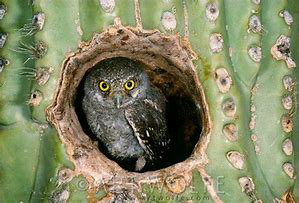 cavity nest, other species may take advantage of the nest site after the woodpeckers have moved on. American Kestrels, Purple Martins, Screech Owls, Elf Owls, Ferruginous Pygmy-Owls, Brown-crested flycatchers and Ash-throated flycatchers all use these nesting holes.
cavity nest, other species may take advantage of the nest site after the woodpeckers have moved on. American Kestrels, Purple Martins, Screech Owls, Elf Owls, Ferruginous Pygmy-Owls, Brown-crested flycatchers and Ash-throated flycatchers all use these nesting holes.
The introduced species European Starlings and House Sparrrows are particularly aggressive cavity nest thieves. These species are known to move right into an active nest and proceed to stuff the cavity with grasses, trash and other nesting material until it protrudes from the opening. Their eggs are then laid in the cushy nest.
Bats, lizards, mice and invertebrates also may find saguaro holes provide attractive shelter and protection from temperature extremes. At the bottom of the cavity nest droppings and uneaten food remains attract more uninvited guests such as beetles, flies, maggots, and ants who benefit from the humid and protected environment. In some cases, the nestlings simply hang out in the midst of the other critters with no harm done. Screech Owls and Elf Owls have been known to bring live blind snakes to the cavity.* The blind snakes live in the debris and consume the bugs. Now there’s a house keeper!
*A Guide to Southern Arizona Bird Nests and Eggs by Pinau Merlin
Fascinating Feet
Claudia Kirscher
Liberty Wildlife Volunteer
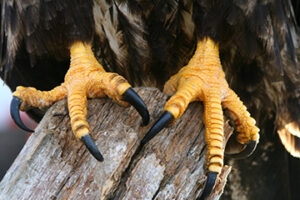
Bird feet come in many different shapes and sizes. As with bill shape, a bird’s foot can tell us the behavior/lifestyle of the bird possibly even type of food. There are three main functional foot types: grasping; walking/wading; and swimming..Bird feet are not only used for locomotion, they serve in perching, foraging, catching/killing, preening, and thermo-regulation. The arrangement of a bird’s toes depends on function.
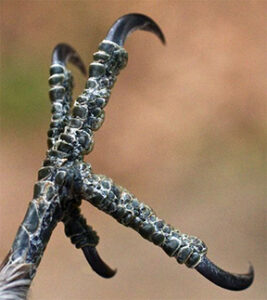
Two toes pointing forward and 2 backwards for climbing up, down, and sideways on tree trunks, sharp nails for digging into the wood and back toes so that bird does not fall backwards (woodpeckers, parrots, toucans, and cuckoos).

Song birds have 1 toe pointing backwards and 3 forward for grasping perches as well as scratching and digging in dirt and leaf litter for seeds and insects (towhees, sparrows, most passerines). Hummingbird feet are used only for perching not walking.
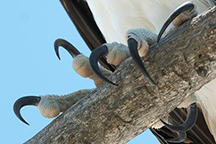
Raptors such as Osprey (photo) eagles, hawks, falcons, and owls have large talons to capture, kill, and carry prey. Toes are typically 3 toes forward and 1 back. The 4thtoe of osprey and owls can be moved around to the back position for carrying prey.

The undersides of the toes in raptors have roughened pads which help the foot grasp their prey.

Water birds have webbing between the toes for paddling efficiently through water as well as walking on shore.


In wading birds, the long toes spread the bird’s weight over a large surface area to walk on water plants or near the water’s edge.
 Some toes are highly specialized for walking on water plants and swimming such as American coots and grebes who have lobate toes. Lobate toes enable them to “run” along the water surface in order to lift off for flight.
Some toes are highly specialized for walking on water plants and swimming such as American coots and grebes who have lobate toes. Lobate toes enable them to “run” along the water surface in order to lift off for flight.

In flightless birds, where running speed is essential for survival, 2 toes (ostrich) or 3 toes (emu) face forward. They also protect themselves by kicking with their powerful feet and sharp claws.
Most bird species have 4 toes…. three forward and one back or two forward and two back. The back toe is called the hallux and is labeled as #1. The next toe, on the inside, is #2, the middle toe is #3, and the outside last toe is #4. Each toe has separate bones, two bones in #1, three in #2, four in #3, and five in #4 toe.
Several birds have a specialized #3 (middle) toe called a pectinate toe. This can be found on one or both feet, on the talon or claw. It is longer, has serrated edges and is used for preening, and removing feather shafts along with debris and parasites from feathers in areas that a beak cannot get to such as the head and neck area. Great blue herons, egrets, barn owls, and night hawks are among the few with this comb-like adaptation.
Feet help to regulate a bird’s body temperature in very cold environments, keeping their feet from freezing and avoiding frostbite. There is very little fluid in the cells of their feet which are mostly tendons and bones with little muscle or nerve tissue. The blood vessels going to and from the feet are close together and cold blood in the feet is warmed by warmer body core blood flowing towards the feet. Circulation is fast so blood does not have long enough time to freeze. Birds will also stand on one foot with one foot up in their warm downy belly feathers. They will also lower their bodies down to cover their feet with feathers.
Feet…..an amazing tool of adaptation !
References: Wikipedia; allaboutbirds.com; infinitespider.com; Audubon.org; merriam-webster.com
Kid Stuff
Carol Suits
Nurturing Nature

Did You Know?
What can you learn from birds’ feet?
Let’s look at these birds’ feet. Can you tell which feet belong to water birds, or birds that grasp branches in trees or birds that capture prey? Click HERE for a video
Maybe you know a lot about birds. Find out! This quiz is fun and helpful.
Spring is coming and many animals are preparing to have babies.
Birds build nests using material they find nearby. VIEW VIDEO
This hummingbird building a nest. What material is the bird using? VIEW VIDEO
Animals can be very clever. Find the nest that is constructed to protect babies and fool unwanted visitors by having a “false” opening.
Click HERE to learn about nests
Puzzles!


